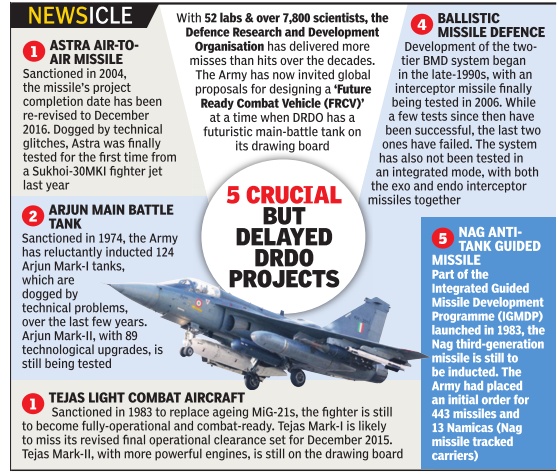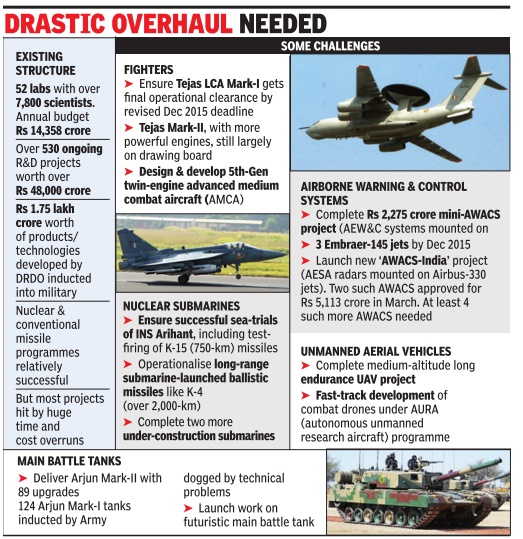Defence Research and Development Organization (DRDO)

This is a collection of newspaper articles selected for the excellence of their content. |
Missile test-firing range at Wheeler Island
India’s solitary missile test firing range faces sand erosion PTI 2013/05/12
Chennai: Changing sand patterns around India’s lone missile test-firing range at Wheeler Island off Odisha coast is causing serious concern for the Defence Research and Development Organisation that is seeking assistance from Chennai-based National Institute of Ocean Technology to control the erosion.
“Due to erosion, some 300 metre of sand area has submerged and some sand is showing up in other part of the island,” DRDO chief controller (R&D) Avinash Chander said.
Since Wheeler Island is technically a “sand bar” with a size of approximately 1sq km in the Bay of Bengal and not a rock formation, water currents result in the change in sand patterns, he said. PTI
Revival
The Times of India, May 31 2015

Rajat Pandit
With the Modi government keen to build a strong defence-industrial base in tune with the `Make in India' policy , the stage has now been set for revival of the country's moribund defence R&D establishment by the appointment of two relatively younger scientists at the helm of affairs. The government is quite miffed with the lackadaisical functioning of the Defence Research and Development Organization (DRDO), often in the dock for its failure to deliver cutting-edge weaponry without huge time and cost overruns, with Prime Minister Narendra Modi himself warning the organisation to fast shed its “chalta hai“ attitude.
But only time will tell whether S Christopher, 59, the new DRDO chief, and G Satheesh Reddy , 51, the new scientific adviser to the defence minister, can undertake the kind of drastic surgery that is needed to revive DRDO and its 52 labs spread across the country . India, after all, still continues to import 65% of its military hardware and software.
Officials say Reddy's appointment in the MoD, by splitting the scientific adviser-cum-DRDO chief post, will provide an “independent mechanism“ to review and scrutinise DRDO's functioning. Till now, the same scientist wore the two hats.
“More changes are on the anvil. They could include a new defence technology commission and a commercial arm for DRDO, as was recommended by the Rama Rao committee (RRC),“ said an official. “There is a big thrust on Make in India, which will include greater private sector participation as production agencies or lead integrators for technologies developed by DRDO,“ he added.
As earlier reported by TOI, the RRC in 2008 held that DRDO should focus only on eight to 10 “critical tech nologies“ of “strategic importance“. But many of its recommendations have been implemented half-heartedly, with DRDO still continuing to make everything from dental implants and mosquito repellents to nuclear missiles and fighter jets.
Modi's advice in August last year that at least five DRDO labs should be headed by scientists under the age of 35 to reinvigorate the organisation is yet to be acted up on. Though DRDO scientists are supposed to retire at 60, many were routinely getting two-year extensions till now.
“Four of the seven cluster heads or DGs in DRDO are currently on extension after retirement, as are most of the `distinguished scientists'. They believe in statusquo and are risk-averse. Consequently , many young scientists get frustrated, adding to the already severe braindrain,“ said a scientist.
DRDO, of course, also gets a measly 6% of the overall defence budget when it is 12% in the US and 20% in China. Apart from the braindrain and failure to attract bright young scientists from top-rung institutes, the DRDO has also suffered from a virtual freeze in the enhancement of scientific manpower for over a decade. It has asked for sanctions to recruit around 300 young scientists every year, instead of the 70-80 inducted at present.
Reforms
Is DRDO’s makeover just cosmetic?
Measures Slated To ‘Transform’ Body May Make It More Bureaucratic And Top-Heavy
Rajat Pandit | TNN
New Delhi: It needed drastic surgery but only first-aid has been rendered. Or, so it seems from the government’s halfhearted steps to revamp Defence Research and Development Organisation (DRDO), whose projects continue to be plagued by huge time and cost overruns.
Defence minister A K Antony approved a series of measures which — it was grandiosely proclaimed — will ‘‘transform and revitalize’’ DRDO in both ‘‘form and substance’’. The measures range from creation of a Defence Technology Commission (DTC) headed by Antony and de-centralization of DRDO’s management to hiving off some of its labs and setting up a commercial arm with seed capital of Rs 2 crore.
The other steps include development of Mark-II versions of the long-delayed Arjun main-battle tanks and Akash surface-to-air missile systems as well as consultation by an ‘‘eminent human resource expert’’ to restructure DRDO and selection of industry partners by evolving ‘‘a suitable mechanism’’.
But there is scepticism whether all this will actually transform DRDO into a lean and mean organisation capable of delivering cuttingedge weapon systems to the armed forces.
For one, MoD will decentralise DRDO management through creation of seven ‘‘technology domain based centres’’ or clusters of labs — missile systems, aeronautics, armament & combat engineering, electronics & communication, material sciences, naval systems and life sciences.
But there are fears all this will make DRDO even more bureaucratic and top-heavy, especially since each such cluster will be headed by a director-general and his associated paraphernalia. DRDO, with its 51 labs, currently has one director-general at the helm. After being redesignated as chairman, he will head the DRDO management council consisting of seven DGs, four chief controllers (R&D) and an additional financial advisor at the HQ.
For another, MoD has decided to hive off only three of its 51 labs, two to CSIR and one to ICAR, instead of the dozen or so recommended by the Rama Rao Committee report.The Rama Rao report had stressed DRDO should concentrate only on 8 to 10 ‘critical technologies’ of ‘strategic importance’ instead of also venturing into making juices, mosquito repellents, titanium dental implants and the like.
The creation of DTC is being done to allow DRDO to have a greater say in defence procurements from abroad. Armed forces, however, already feel DRDO often derails armament deals by pledging to develop the systems concerned but does not make good its promises. Defence scientists, on their part, contend the services are often against indigenisation, with foreign arms lobbies always ready to play ball in deriding DRDO.
There is, of course, no getting away from the fact that India needs to develop a robust industrial-military infrastructure, importing as it still does around 70% of its military hardware and software. Incidentally, India has inked defence deals worth a staggering $50 billion since the 1999 Kargil conflict, the overwhelming majority of them with foreign armament firms. DRDO REBOOT Status of the weapon systems developed by the agency
Missile Programme
Sanctioned: 1983 Trishul and Akash SAM systems: Not inducted Nag anti-tank guided missile: Not inducted
Prithvi (150-350km) and Agni-I (700km): Inducted Agni-II (2000km) and Agni-III (3,500km): Being operationalized Agni-V (5,000km): First Test in 2011
Tejas LCV
Sanctioned: 1983 Original Cost: Rs 560 cr Revised cost: Over Rs 13,000 cr with FSED (full-scale engineering development) extended to 2018 Status: Final operational clearance for IAF LCA is Dec 2012 and naval LCA is Dec 2014
Kaveri Engine (Tejas)
Sanctioned: 1989 Original Cost: Rs 383 crore Revised cost: Rs 2,893 crore Status: Not operational Arjun Tank
Sanctioned: 1974 Original Cost: Rs 15.5 cr Revised Cost: Rs 306 cr Status: First regiment inducted only in 2009. Army keen on inducting 1,657 Russian-origin T-90S tanks and only 124 Arjuns for its main battle tank requirements for the immediate future